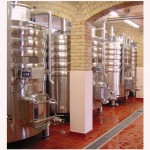

Study after study has shown that red wine is very rich in phenolic compounds that not only contribute to the sensory characteristics of the wine, but also provide numerous health benefits. These antioxidant polyphenols, including resveratrol, have been shown to play a role in protection against cardiovascular disease, inflammation, and some cancers. Resveratrol, which is a polyphenolic compound found in the skins and seeds of grapes is produced by grape vines in response to fungal infection, is believed to be beneficial for human health because of its ability to; inhibit the oxidation of low-density lipoprotein, block platelet aggregation, and activate vasodilatation.
Resveratrol concentrations depend heavily on a variety of factors, including the variety of grape, harvest year, climate, the extraction technique, and winemaking practices used. Studies have shown that different winemaking practices can influence the phenolic composition of wine. Specifically, fermentation temperature, thermovinification, must freezing, and extended maceration techniques have all been shown to increase polyphenol levels in wine. On the other hand, certain treatments such as the addition of certain SO2 levels and cold-soak techniques have been shown to have little to no influence on polyphenol content in wine, while some studies actually showed a decrease.
Certain factors, such as harvest year and climate, cannot be controlled by the winemaker, however, factors such as winemaking technique most certainly can be controlled, therefore the winemaker is able to adjust his/her technique accordingly to achieve the desired goals of the final wine in regards to not only sensory characteristics but also polyphenol levels. One recent study examined the influence of grape variety and winemaking technique on the polyphenol composition of red wine by using the techniques: “double pasta” (addition of extra pomace during fermentation or separation of must from pomace) and thermovinification (destroys cell membranes of grape skins, releasing components into the must).
Results of this study showed that grape variety plays a huge role in the phenolic composition and antioxidant capacity of red wine. As a result of this large variability, one cannot simply apply a particular winemaking technique to any grape variety and come up with the same outcome every time. The results of this study show that each grape variety reacts different to different winemaking technique, and one must have a good understanding of the entire system before making any decisions on which winemaking technique to use for a particular grape variety.
This study did find that certain winemaking techniques were better for obtaining higher levels than others, though the types of techniques they examined were not all inclusive. They found that thermovinification techniques (heating of the crushed grapes at a certain temperature for a certain period of time) were the most effective at increasing the polyphenol content in the finished wine, though relative concentrations differed, depending upon the grape variety. If the ultimate goal is to create a wine with higher levels of health beneficial polyphenols and antioxidants, the results of this study make it clear that first, grape variety choice is extremely important, and that second, winemaking technique choice is also important.
Ideally, more work needs to be done that includes many different types of grape varieties, as well as many other types of winemaking techniques, in order to get a clearer picture of how winemaking practices affect the concentrations of health benefiting polyphenols in finished wines.
For greater detail on this study, please visit The Academic Wino.
Image Source: http://www.technicom-france.com/images/c_0gd.jpg
About The Author
Rebecca Yeamans
Becca Yeamans is the owner/writer of the science-based wine blog, The Academic Wino, as well as the Tasting Room Manager at a vineyard in central Virginia. With a Bachelor of Science in Biology and a Master of Science in Environmental Science, her solid background in science and research allows her to approach wine blogging with a unique style that is both informative to those in the industry, and entertaining for those simply wishing to learn.

